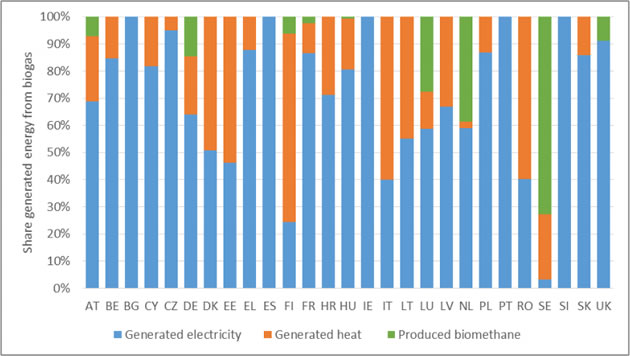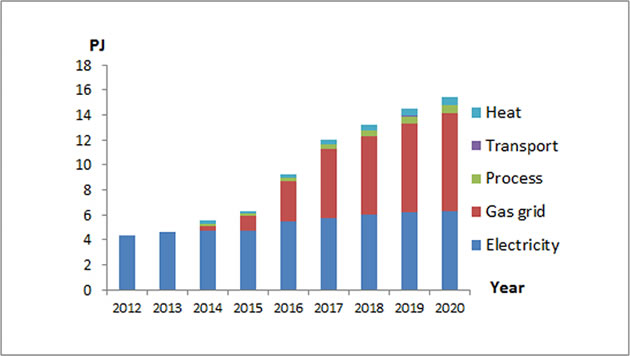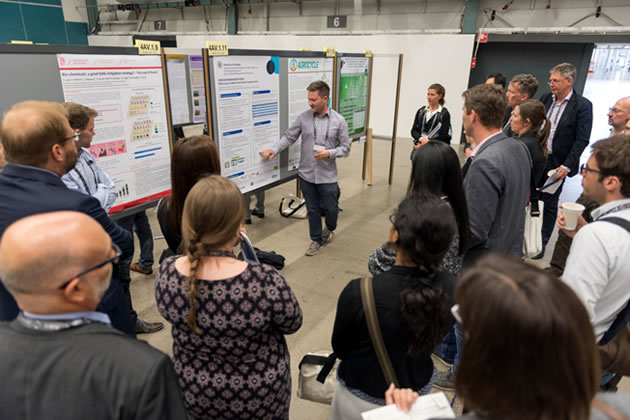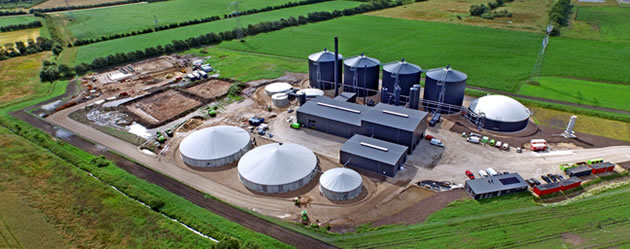 |
      |
| |
Perspectives for biogas in Europe
|
|
A recent study by the European Commission has examined the use of biogas – gas produced from organic waste – as an energy source in Europe, and has shown that due to successful policies in various Member States, EU-wide biogas production increased rapidly in recent years.
As the EU works towards its ambitious energy and climate targets for 2020 and 2030, biogas can be a flexible and sustainable alternative source of energy, supporting energy security and greenhouse gas emission reduction in electricity, heating and transport. However, in some EU countries the absence of policies promoting biogas means that currently its full potential is not being used.

Generated energy from biogas per Member State (EBA, 2015). Source: European Commission
On the other hand, positive news in the field of biomethane production through biogas upgrading has been recently reported, such as, for example, the approval by the European Commission under EU State aid rules of an Italian support scheme for the production and distribution of advanced biofuels, including advanced biomethane. The measure will contribute to reaching EU energy and climate change goals while limiting distortions of competition.
In addition, as reported by the Biogas Barometer 2017, each of the European countries under study has at least one of the four aid mechanisms specific to biomethane injection: feed-in tariffs dedicated to biomethane injection, grid injection priority, grants for creating installations and guarantees of origin or renewable gas quotas. These mechanisms are geared to achieving the European or national RES targets.
Germany dominates the European market with 201 plants in 2016 and its output is more than 50% of the combined output of the nine countries included in the 2017 Biogas Barometer study. The UK has posted impressive growth, overtaking Sweden, the sector’s historical pioneer, in less than six months. Sweden’s sector is currently stagnating slightly along with that of the Netherlands. France has recorded a sharp rise in the number of plants but lags a long way behind the European leaders. Lastly, Denmark has the distinction of operating Europe’s largest plants. Biomethane-dedicated feed-in tariffs have been the growth drivers in Germany and are the reason why the sector is growing fast in France, Denmark and the United Kingdom.
How biogas is moving forward in Denmark |
 |
"I work to make Denmark independent of fossil fuels by 2050. The government wants to secure a sustainable and reliable supply of energy, water, heat, telecom, and internet. And the price has to be affordable for both consumers and businesses", says Lars Chr. Lilleholt, Minister of Energy, Utilities and Climate, Denmark.
In this context, the production of biogas is rapidly increasing in Denmark. Biogas is promoted through subsidies according to its use. To date the majority of the produced biogas is used in electricity production. In the future it is expected that a greater share of the produced biogas will be upgraded and delivered to the natural gas grid. Biogas must be upgraded to biomethane before injected into the Danish gas transmission system and traded on the conventional gas market. Conversion of biomass to biogas comprises agricultural residues and industry waste, and Denmark hosts two types of biogas plants:
-
Joint biogas plants, which receive manure and waste from a number of farms, as well as industrial and household waste. The gas produced in these installations is sold to local CPH plants.
-
Farm biogas plants, which utilise the waste from a single farm, mainly manure.

Historical and expected future biogas production and its use in Denmark 2012-2020. Source: Danish Energy Agency
In terms of biogas utilisation, Denmark has a strong infrastructure for utilising biomass in biogas plants. The first upgraded biogas from slurry was injected into Danish natural gas grid in January 2014. The goal over the next 3-5 years is to steadily increase injection of upgraded biogas into the natural gas grid, which is able to reach 250,000 natural gas consumers. Biogas is currently promoted through public subsidies according to its use. The different support schemes for biogas include the following uses:
-
Production of electricity
-
Upgraded biogas delivered to the natural gas grid or cleaned biogas delivered to a town gas grid
-
Use of biogas for process purposes in the industry
-
Use of biogas as a transport fuel
-
Use of biogas for heating purposes
Biogas: One of the key topics of EUBCE 2018 |
 |
More than 80 contributions have been submitted to the topic "Anaerobic digestion for biogas production and biogas upgrading" and many others directly refer to biogas and biomethane.
Thanks to this great response, two visual (poster) sessions on Wednesday 16th, May are addressed to Anaerobic digestion and biogas production (2CV.5) and to Biogas treatment and upgrading (2CV.7) discussing the optimisation of biogas processes by feedstock selection, technologies design and gas production, evaluating results of different pilot and laboratory tests and samples analysis, including developments for optimising processes for biogas treatment and upgrading to methane production.

Three oral sessions on Thursday 17th May are focused on Techno-economic evaluation of small-scale systems and biogas upgrading (2DO.1), Biogas feedstocks and pretreatment technologies (2DO.4) and Biomethanation, Thermal methanation and microbial power to gas (2DO.7). These sessions cover different approaches for small scale systems in order to evaluate techno-economical aspects of biogas production process, assess the challenges of processing various feedstocks in anaerobic digestion, taking into consideration a series of food industry wastes and by-products, agricultural residues and microbial populations, and to present an outlook on the latest trends in technologies for converting and upgrading biomass and derived gas into methane. Other presentations discuss how and where biogas may be used and managed to enhance the penetration of variable renewable energy sources on power grids and power generation systems.
EUBCE 2018 Technical Tour to Nature Energy's Holsted Biogas Plant |
 |
In this context, the EUBCE 2018 Technical Tour to Nature Energy’s Holsted Biogas Plant organised on Friday 18th, May, shows one of the largest and most advanced biogas plants in Europe converting 400.000 t of biomass into 13 million m3 of pure methane for injection into the extensive Danish gas grid.

   
More information on www.eubce.com
|
|
|
|
|
|
|
|
|
|
|
|
|
|
|
|
|
|
|
| |
INSTITUTIONAL BIOMASS INDUSTRY COOPERATION
|
|
|
|
|
|
|
|
|
|
|
|
|
|
|
|
|
|
|
|
|
|
|
|
|
| |
Organised by
|
with the support of
|
|
|
|
|
|
|






